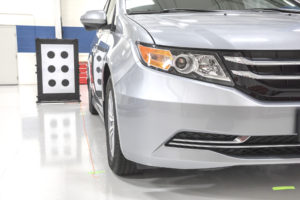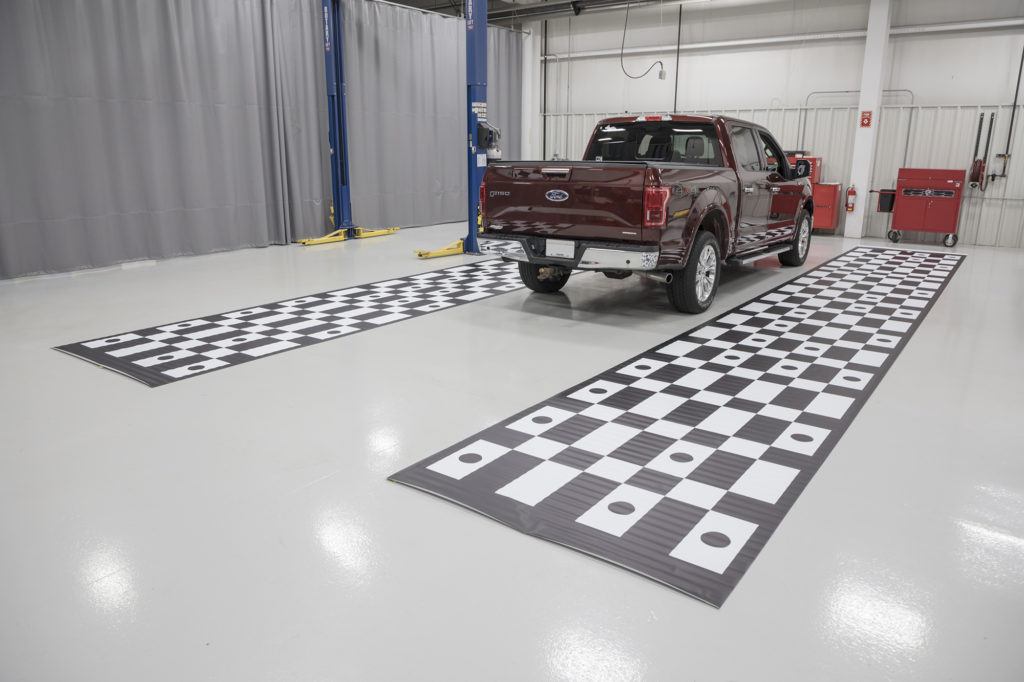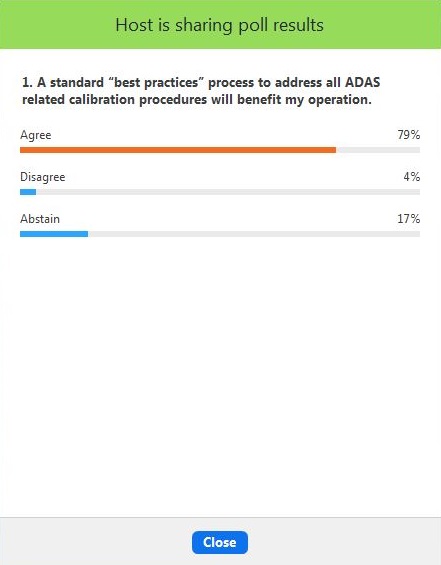
CIECA developing workflow for repairers handling ADAS, documenting those steps
By onAnnouncements | Associations | Business Practices | Education | Insurance | Market Trends | Repair Operations | Technology
Repairers and insurers overwhelmed with the concept of advanced driver assistance system calibration might soon take comfort in a new workflow aid being developed by the CIECA Calibration Committee.
The document won’t be a substitute for researching and following the specific OEM repair procedures for the vehicle in front of you. In fact, the workflow directs you to use manufacturer instructions during multiple stages of the process. But it might help body shop owners and managers organize their staff, operations and documentation, and it might help insurers and customers to understand that process.
The draft workflow presented to the July 22 Collision Industry Conference — more revisions are expected before it’s finalized — lays out some general steps which would occur during a repair and suggests when and how a repairer would document these.
“This is for the use of the industry,” CIECA Calibration Committee Chairman Darrell Amberson said of the workflow.
An informal CIC audience poll saw 79 percent of respondents agreeing that a standard “best practices” process for ADAS would benefit their operation. “I guess that’s rather compelling,” said Amberson (LaMettry’s Collision).
Committee member Chuck Olsen (AirPro) said the workflow was a byproduct of a Collision Industry Electronic Commerce Association messaging initiative. The neutral industry electronic standards association had sought to create BMS messaging supporting documentation relating to ADAS activity, according to Olsen.
The CIECA project drew more than 70 members participating in the committee over the past year and a half and included representation of various industry segments, Amberson said.
Amberson said the workflow encompasses all diagnostic scanning but also calibration and other operations that “go well beyond scanning.” After all, a scan typically doesn’t identify if calibration is required or had been performed correctly, he said.
The workflow walks a repairer through a hypothetical calibration, frequently directing the repairer to step back and document what’s been learned. It also proposes notes a shop might provide to a dealership or other third party sublet vendor.
In that vein, Amberson said a repairer could provide the workflow itself to a sublet provider, declaring that the shop expected the vendor to perform these steps and document the work in this fashion.
Committee member Gene Lopez (Seidner’s Collision Centers) walked the virtual audience through the draft workflow July 22. Repairers should note the significant amount of documentation a shop might wish to collect as a best practice.
One caveat: CIC Chairman Jeff Peevy (now-I-CAR; then-Automotive Management Institute) stressed that CIC disclaimed any warranties or guarantees related to the document and wouldn’t be liable for damages related to it or reliance on it. CIC wasn’t providing legal, repair or other professional services, and shops should seek competent aid if they want such services, he said.
ADAS workflow
After possibly an optional pre-repair test drive, a repairer would scan the vehicle, review the results, and research both the scan output and the OEM repair procedures.
At this point, the repairer would break off to document the pre-scan and research findings, and “you must include” a valid VIN, Lopez said. (He noted that the scan tool should capture it.)
The repairer would proceed to determine all the ADAS features available on the vehicle, including through visual inspection, OEM build data, and asking the customer what’s on the car, according to Lopez.
After obtaining the repair procedures, the shop would document the ADAS — and any pre-existing damage — present and the repair procedures.
The shop would blueprint and disassemble the vehicle and then create a repair plan. The repairer would also check for ADAS here.
“Now we have to emphasize to document, document and document,” Lopez said. This would include documenting the work necessary, who will do it, which calibrations are needed, and the dates and times associated with the retrieval of information like OEM procedures.
Then it’s time to actually fix the car following OEM repair procedures, potentially holding off on some reassembly that would prevent work on ADAS systems, according to Lopez. For example, he said, you might not reinstall a grille which covers an ADAS module quite yet.
The body shop would then post-repair scan the vehicle, according to Lopez. The shop would document any diagnostic trouble codes and the repairer’s assessment, and follow OEM repair procedures for any programming and module setup, followed by another batch of documentation of this digital work on the modules.
Such programming might clear diagnostic trouble codes, which means the repairer would “perform a second post-scan” to verify everything’s fine, according to Lopez. You’d document that the scan revealed no DTCs. However, if the second post-scan revealed codes, you’d document the remaining DTCs and keep researching the issue — documenting those findings and repair procdures as well. Once the scan came up clean, you’d finally be able to document that and move on.
After the vehicle digitally appeared to be working properly, the repairer would proceed to the recalibration, assuming it was needed. “In some cases, it’s not,” Lopez said.
The shop would identify and then document it had the repair procedures, tools and personnel needed. The shop would follow this by confirming prerequisities like a full tank of gas, proper tire pressure or a wheel alingnment had been met and examining whether the vehicle had been altered — for example, lifted to a different ride height.
If the vehicle had been modified, the shop would explain to the customer that the alterations might compromise the ADAS, though Lopez noted this conversation might have already happened at intake.
The repairer would document it had met the prerequisites and any modification-related issues. and move on to performing the actual calibration following OEM repair procedures. Lopez said the subsequent documentation the calibration was done right could involve photos, videos and screenshots and might be required by an automaker or insurer anyway.
It’s then time to test-drive the car, followed by documenting the test-driving personnel, date and time of the operation, and proof it achieved the proper results. If the test-drive reveals the repairer failed to get the job done, then they’ve got to skip backwards a few steps and repeat the process until things are right.
After a final scan reveals everything is good to go, the shop can move on to the quality control and detailing phase before returning the vehicle to the owner. (Oddly, the workflow doesn’t describe documenting any of these steps.)
Upon delivery, the repairer should review ADAS with the customer and notify them it has been returned to OEM specifications. He said often, customers will inform the body shop (it was unclear if he meant Seidner’s specifically or was speaking about the industry as a whole) that they deactivated ADAS because “‘It bugs the heck out of me.'” The repairer would therefore explain to the customer that these features have been reactivated and operate correctly. The shop would document this conversation as well.
“Note: All Documentation Has Personnel, Dates and Times Associated with it,” a slide presented at the CIC stated.
Olsen said the document could be used for “just about any manufacturer” given the constant references back to OEM procedures. “The group was in consensus” this was important, he said.
The committee plans to link the flowchart and a means of viewing the recommended documentation, according to Olsen. It also seeks to produce a video discussing the workflow and promoting best practices.
Asked if the product had been discussed with insurers, Olsen said insurers had been involved with the development process. “To a point, there has been some awareness,” he said.
Amberson said the committee’s mindset was to provide ADAS verification to an insurer or anyone else who might want it, and so the body demanded documentation of many steps in the process.
Lopez said his conversations with field adjusters find them aware of Seidner’s process, which he called similar to the CIECA committee’s proposal. He said he felt many insurers were aware of Seidner’s work, and the industry was beginning to understand the importance of a calibration workflow and its documentation.
More information:
Collision Industry Electronic Commerce Association website
CIECA Calibration Committee/CIC Emerging Technology Committee slides (Note: This is a draft version; further revisions expected)
Collision Industry Electronic Commerce Association via Collision Industry Conference, July 22, 2020
Images:
A target is placed behind a 2017 Honda Odyssey to recalibrate a lane-watching camera’s aim. (Provided by I-CAR)
Calibration mats are positioned along the left and right sides of the 2015 Ford F-150 to recalibrate the surround view cameras. (Provided by I-CAR)
Results of an informal poll of the virtual Collision Industry Conference audience on July 22, 2020. (Screenshot from virtual Collision Industry Conference)


